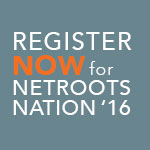After a great run, the Winning the Internet blog has been retired. However, you can still keep in touch with New Media Mentors here.
As we gear up for Netroots Nation 2013, we’re taking a closer look at some of the convention’s hottest training sessions. We’re interviewing the trainers and taking you inside some of online activism’s most popular and elusive topics.
Today we’re interviewing Dheeraj Chand and Tim Anderegg, who’ll be leading Make It Pop: Using Data Visualisation To Understand What You’ve Done, are Doing and Should Do.
NN13 Training Session
Make It Pop: Using Data Visualisation To Understand What You’ve Done, are Doing and Should Do
We understand the importance of data-driven work in organizing, but how do we properly understand the data to be driven by them? This training will show you techniques for visualizing and tabling your data so you can properly understand what you’ve done, what you’re doing and where to go, as well as to show you open source software that can do it all.
Interview
Q: How did you get involved in data visualization?
Dheeraj: Since I was a kid in math classes, I have always been really fascinated by the relationship between equations and pictures. Think about something as simple as the equation for the slope of a line, y = mx+b. On its own, it describes a line by showing where on the y-axis the line intercepts when x = 0, as well as how many units up and to the right, or down and to the left, it moves when x varies.
This is simple example, but it shows you how equations that describe certain realities can be shown in pictures. When you get further along in math, and you start seeing beautiful geometries, topologies, etc. And it’s everywhere! You see it in maps, charts, cooking instructions – hell, even in ancient Hindu manuscripts describing the theoretical basis of yoga.
As I started moving up through political work, I started to realise that all these complex realities that we were talking about in these huge, beautiful cross-tabulated reports could sometimes be expressed with more clarity if we started using simple graphics to supplement the tables. So I started introducing 3D bar charts, heatmaps, line chart representations of regression analysis, etc. in reports, and people went nuts for them. Since then, I’ve spent time learning about the theoretical underpinnings of how to best show certain kinds of meanings through certain kinds of pictures.
Tim: Data visualization was a necessary skill that I developed while working on campaigns and for non-profits. Generally, as a data manager, I quickly realized that I spoke a language that few people understand, and in order to communicate effectively I had to rely on report writing and visualization. I created charts and graphs in excel to demonstrate our progress to goals in VR and voter contact, and worked with mapping software to allow our partner orgs to visualize the state of their turf and to make geographic based decisions informed by the data they collected. I was also involved in writing annual reports and political targeting memos, all of which are greatly bolstered by effective visualizations.
Q: In your opinion, why is visualizing and tabling data such an important part of organizing?
Tim: Organizing is largely about telling stories that move people to action, whether it be volunteers you’re trying to recruit or elected officials who need to be convinced about the validity of our arguments. Data visualization is a natural extension of that: you’re trying to tell a visual story about the data of interest. Of course, more and more campaigns are working with heaps of data these days so properly organizing and presenting data is become more than a bonus; it’s a necessary skill.
Q: What is the most important thing to keep in mind when displaying data visually?
Dheeraj: The single most important thing to consider when displaying data visually is that whatever you are doing must answer the question, “What am I trying to understand?” If you want to see a simple summary of what’s going on in hard, concrete terms, you should go with a table. But sometimes, with that level of specificity, certain things can be obscured, so you abstract that out and make it into a graphic. It’s utterly fascinating to me that something that is more abstract, i.e., the graphic, can allow you to to see something more precise. The way that the human mind works is fascinating thing, no?
Q: Why should folks attend your session at Netroots Nation, and how can they connect with you?
Dheeraj: Well, first, my email is dchand@clarityandrigour.com and you can also hit me on Twitter, @dheerajchand. I’m the hardest guy in the world to find, right? You can reach Tim at @tanderegg.
This training is really exciting to me. It’s been developed in conjunction with The New Organizing Institute, so we’ll have both a theoretical walkthrough and a practical demonstration of what you can do when you think like a data scientist. Well give you datasets, the code used to develop the visualisations and the code for the application we’re going to give you.
Come hang out with us if you want to learn to think rigorously to bring clarity to the problems you’re working on. Come hang out with us if you’ve always been interested in understanding the meanings and significance of things. Come hang out with us if you want to learn to make tables and graphics that will make your colleagues exclaim, “OH S***!” with delight.
To attend this training, or one of the 39 others at Netroots Nation 2013 in San Jose, register now.




Comments are closed.